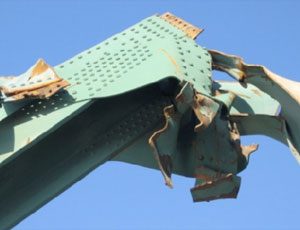Howard Hill, director of technical operations and a principal of Wiss, Janney, Elstner Associates Inc., examined the collapsed Interstate-35W Bridge in Minneapolis. He traded emails recently with ENR Chicago Bureau chief Tudor Van Hampton on how he heard of the disaster, what he found when he reached the scene and how WJE decided the design error was made.

As the first person to point to gusset plates as the failure mode on I-35W, how was this assignment different from others you've tackled in the past, and how was it the same?
The primary difference was the role played by the NTSB [National Transportation Safety Board] and the FHWA [Federal Highway Administration]. On past, transportation-related structural investigations, these agencies might monitor our work, but they did not actively participate in the investigation. On this project, the NTSB assumed control of the site from the beginning, made WJE part of their team, and NTSB and FHWA representatives performed extensive investigative work.

HOWARD HILL
As for similarities with other assignments, there are many: crawling over piles of distorted structural elements to observe and document conditions; poring over design and construction documents to develop an understanding of system characteristics; measuring, testing and analyzing structural components and systems to quantify capacities of critical elements and associated demands and tying it all together into conclusions that make sense. These tasks are common to most failure investigations.
How did you find out about the I-35W collapse, and at what point did you get involved in the forensic study?
I found out about the collapse via a telephone conversation with a television reporter on my way to pick up my son from football practice. For some reason, someone told her she should call me; but of course I had nothing to offer. The next day (the day after the collapse) Mike Koob [senior principal], Jon McGormley [associate principal] and I were in Minnesota, meeting with the folks in the Minnesota Dept. of Transportation.
Once you arrived on the scene, what did you do?
I got on top of the south-end-span deck and walked as far as I could towards the river. This provided a pretty good view of the overall scene. After that, I crawled all over the wreckage at the south end getting oriented as to what I was looking at. After the first day, Jon McGormley and I focused on trying to distinguish between damage that may have contributed to the collapse and damage that was caused by the collapse.
What was it like working alongside other authorities, such as rescue divers? How long did you remain on the scene?
I had no contact or interaction with the rescue teams. They stayed in and around the water, and focused on their mission. I believe that in the early days, the site was kept secure by Minneapolis police. Since they controlled who came and went, I had to work with them to get where I needed to go. The system they had in place worked quite well, and the officers themselves were very nice and professional. As the project evolved, we worked more and more with a variety of folks, mostly from MnDOT, NTSB and FWHA. In all cases, the people we met knew their roles, conducted themselves accordingly and were a pleasure to work with.
On this first trip to the site, I stayed until Sunday [August 5, 2007].
What was the first thing that tipped you off to the gusset plate problem?
There were several engineers roaming around the site in the first few days. I was working with Jon McGormley, Jim Wildey of the NTSB and Joey Hartmann and Bill Wright of FHWA were climbing around in the same areas. I think we all quickly recognized several things: 1) that the 3-span structure separated rather cleanly along two symmetric lines, which coincided with the U10 nodes; 2) that the U10 gusset plates at all four locations (essentially the corners of the center section that fell into the river) came apart in similar ways and 3) that the positions of the U10 node elements were such that it would have been difficult for them to have sustained damaged as a result of the collapse. Taken together, these observations suggested there was something significant about the U10 nodes.
How and when did you gain confidence that this was a workable theory?
On the Monday following the collapse, I went to my office to start checking structural components based on design documents and assumed material properties. Given what Jon and I had seen at the site, I decided to start with the U10 node gusset plates. The first step was an evaluation of the shear flow between the web and chord elements. This is a very simple, yet reasonably illuminating calculation as handling horizontal shear was one of the primary roles for these plates. When this check indicated shear demands were comparable to the probable ultimate strength of the plate--essentially that the plates had been stressed to their limits--it was immediately clear that this was a likely factor in the collapse.
Remember, we already knew that the gusset plates at all four of the U10 nodes had failed in a similar manner, that the failures were consistent with excessive web-to-chord loads and that many of the damaged gusset remnants were in locations where damage due to post-collapse movement would have been unlikely. The following day (Tuesday the 7th) I shared my findings with my colleagues at WJE who verified them, and we then quickly passed them on to the other parties. Everyone quickly recognized the significance of these early calculations and, given a few more days, would have no doubt discovered the problem themselves.
Your client was MnDOT, but the NTSB took this information to the press shortly after the collapse. Was it premature to publicize this before all the evidence was gathered?
I was very happy to see these initial findings made public. Without knowing that the collapse was likely due to a design error, the tendency among bridge owners would be to speculate about the more-common issues associated with older bridges, such as inspection procedures or fatigue and fracture problems, and possibly respond to this speculation by committing excessive resources to addressing issues that had nothing to do with the failure.
Once the victims were identified and the demolition began, how did you go about validating your findings?
This involved two more-or-less parallel efforts: one documentary, the other analytical. In order to be very confident that the initial findings were accurate, we needed to make sure that there were no other, more likely collapse scenarios. To do this, we had to thoroughly examine all of the structural components that could have precipitated the collapse, test samples of structural materials, and document loads. This effort enabled us to account for actual conditions rather than relying on assumed conditions or conditions as described in pre-collapse inspection reports.
Once actual conditions were documented, they were incorporated into our analytical models so that we could provide accurate estimates of structural capacities and the associated demands. I was primarily responsible for WJE’s analytical work. The NTSB did some nice breakdown of a videotape recording that captured part of the collapse. The information they provided by this effort was consistent with our findings.
What new forensic tools or techniques, if any, did you employ in this investigation?
MnDOT had some fascinating surveying capabilities that were used to create high-resolution images of the wreckage before it was disturbed. I don’t remember what it was called, but it consisted of a laser on a tripod that, in an automated fashion, took millions of shots, each one resulting in a dot in the final image. The laser was connected to a computer that stored the data. It could also display the data on a monitor so that you could watch the image develop. Once developed, the digital image could be manipulated like a CAD drawing. While these images didn’t play a role in our efforts to date, they do comprise a nice record of the majority of the wreckage that was not submerged.
Essentially, our investigation was dominated by old-fashioned note-taking, photographs, hand calculations and rather ordinary computer simulations. Remember, from a purely technical standpoint, this was not a particularly complicated event.
Why do you think the gussets were ultimately undersized in the bridge's construction plans?
When I first started thinking about this and discussing it with colleagues, we came up with several possibilities: math error—basically dividing by two one too many times when calculating shear demands on these plates (two trusses, two plates per node...); drafting error—turning 1-in. into ½-in.; confusion over material strength—assuming 100-ksi plate would be used instead of 50-ksi material; or an incomplete design process, where certain critical features of the plates were not checked.
Today, I believe the last explanation is the most likely. Portions of the original gusset-plate design calculations were found. They showed the same ½-in. thick, 50-ksi plate that was called for in the design drawings, and they did not contain any extra divisions by two. While we did not have a complete set of the calculations, it appeared to me that they did not include all of the checks needed to get the right plate thickness.
A lot of information existed on this bridge. Why didn't anyone discover this before?
Once a bridge is put into service and traffic is allowed on it, it must be assumed that there are no major design deficiencies. If this were not the case, it would of course be irresponsible to open the bridge.
Once adequate design is assumed, subsequent structural work naturally focuses on damage that can lead to deficiencies in once adequate members. As long as the damage remains minor, no actual analyses need to be done. In fact, even if damage to a particular element becomes significant, its capacity can usually be established without actually calculating its strength. This is because the original design effort typically includes a summary of most member capacities, so that the current capacity can be reduced in proportion to the amount of damage that exists.
Actual, independent calculation of an element’s existing capacity only becomes necessary when these approximate efforts do not indicate adequate strength, and it is believed that a more accurate analysis of the element will indicate a significantly higher strength. So, independent verification of the design of a particular element is rather rare, and when it does happen, it is usually after substantial damage had been sustained.
Again, this is inevitable in an in-service bridge where the assumption that the design is adequate is a corollary of the fact that the bridge is in service. In the case of the I-35W Bridge, the condition of the structure was such that load ratings and other evaluations could be carried out by simply relying on the original design capacity tables, making conservative reductions in tabulated capacities in the few cases where deterioration warranted.
What new lessons about bridges, if any, can engineers learn from all this?
I am not sure there are any new lessons to be learned here. This catastrophe was caused by a design error, and the dangers posed by design errors are well understood. In fact, this error was a very simple one that should have been readily apparent to someone checking the design calculations. In the grand scheme of things, this is very good news.
Had the problem with the I-35W Bridge been something truly subtle, mysterious and fundamental that lay hidden from the engineering profession until now, we would have a systemic problem of huge proportions on our hands! Thankfully, the truth is utterly anticlimactic.


Post a comment to this article
Report Abusive Comment